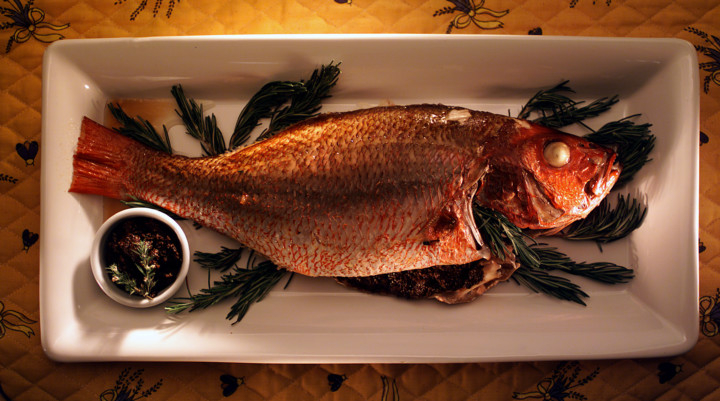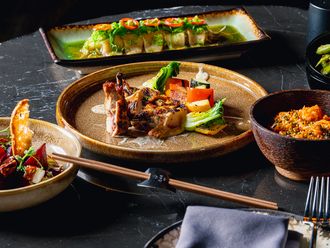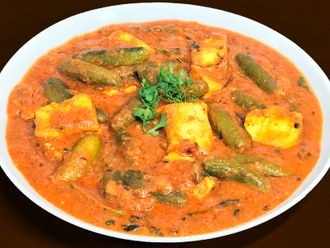
There are few things easier to cook than a whole fish.
And not only is a whole fish more beautiful to serve than a fillet (once you get past that silly “Eek! It looks like a fish!” reaction — what are you, in fifth grade?), it tastes better too. Just like any other meat cooked on the bone, fish cooked in the round is moister and more flavourful.
Even better, it’s incredibly flexible. You can use almost any cooking technique you can think of, and you’ll get a very different dish each time.
Probably the easiest is simply steaming it, in the Chinese fashion: put the fish on a plate; sprinkle it with shredded ginger, green onions and a little soya sauce; put the plate in a steamer and cook. In 10 or 15 minutes, you’ll have a perfectly moist, beautifully fragrant dish.
No, wait, maybe it’s roasting: stuff the cavity with herbs and lemon slices; put the fish on a baking sheet; scatter a few lemon slices over top and bake at 400 degrees for 10 to 15 minutes. The skin will crisp slightly and the meat will pick up hints of the herbs and lemon.
Or you can simply grill it over a medium-hot fire or under the broiler and the only thing the fish needs to be complete is a light drizzling of flavoured oil.
The list goes on. You can poach a whole fish in a pan of barely simmering, fragrant fish broth. You can even deep-fry it by dusting it with flour or cornstarch and submerging it in bubbling oil. (Use a slightly lower temperature of 350 degrees to avoid scorching the outside before the centre is cooked through.)
Most of the whole fish you’ll find at the market belong to one of two fairly similar species, though this can get a little confusing because fishmongers have always felt perfectly comfortable calling fish by names that rightfully belong to other species.
Rockfish is, of course, the classic fish to cook whole, and now that it is making a comeback, you certainly should seek it out.
Probably the most commonly found whole fish at local markets is usually called New Zealand snapper or Tai snapper (the latter is not a misspelling — tai is the Japanese word for this kind of fish). Though it is a very good fish, it is not truly a snapper; it’s a porgy. Neither is it real Japanese tai. It’s a cousin, along with the fish the French call daurade. It is caught in the wild, mostly off New Zealand.
The other most commonly available whole fish is the variety that is alternately called loup de mer or branzino, depending on whether the market is feeling French or Italian that day. This fish, once hard to find in the United States, has become widely available now that it is farmed in several Mediterranean countries. (The wild version is still available but only rarely and at elevated prices.)
From time to time, you will also find other whole fish, including wild striped bass. (Don’t mistake it for its farmed freshwater cousin, which often tastes as muddy as tilapia.)
All of these fish have a sweet, mild flavour. Their flesh is firm and flaky — at least compared with sole, which is soft and flaky, and shark and swordfish, which are firm and meaty.
And while these fish certainly are not the same, they are similar enough that they can be used interchangeably in recipes — such as substituting lime for lemon, the results will be different, but they will be good.
___
WHOLE FISH WITH TAPENADE
Total time: 1 hour
Serves 4
1 large whole fish, about 1.10g, preferably a white-fleshed fish such as sea bass, red snapper, porgy (daurade) or striped bass
Salt
Freshly ground pepper
1 tbs olive oil
1/2 cup plus 1 tbs Classic Tapenade, divided
2 or 3 sprigs rosemary
Juice of 1/2 lemon
Lemon wedges, for garnish
Steps:
Heat the oven to 425 degrees. Oil a baking dish large enough to accommodate the fish.
Rinse the fish with cold water and pat dry. Sprinkle it on both sides with salt and pepper, then rub with the olive oil. Measure the fish at the thickest point to determine how long you will bake it. Place a heaped tablespoon of tapenade and the rosemary sprigs in the stomach cavity of the fish. Place the fish in the baking dish. Pour the lemon juice over the fish and cover tightly with foil that has been lightly oiled on the underside.
Bake the fish for 5 minutes per 1/2 inch of thickness. Remove it from the oven, and test for doneness. It is done if it is opaque and pulls apart easily with a fork at the thickest point.
Serve the fish with the remaining tapenade on the side.
Nutrition per serving: 82 calories; 668mg sodium; 9mg cholesterol; 8g fat; 1g saturated fat; 2g carbohydrates; 4g protein; 0.59g fibre.
— Los Angeles Times
















